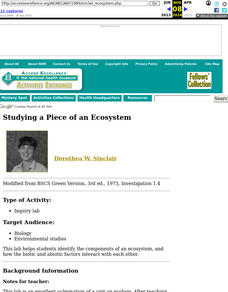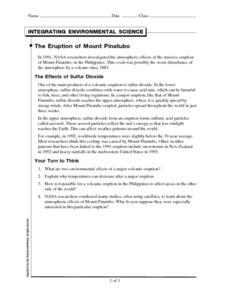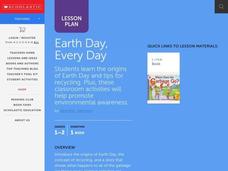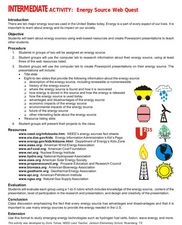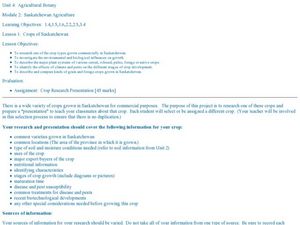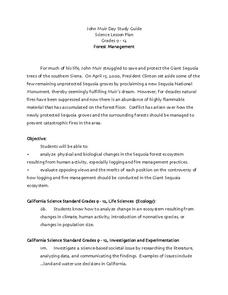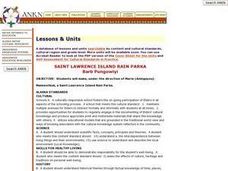Curated OER
Studying a Piece of an Ecosystem
Students carry out an outdoor land study in which they identify organisms living in the soil, and any other animals living within the site. Groups also examine abiotic factors. They respond to a series of questions concerning their data...
Curated OER
Wetland Adaptation
Learners participate in a simulation to investigate the impact of the wetland environment on the migration of birds. They discuss the patterns of migration they took and why they avoided certain wetlands.
Curated OER
EPA Pesticides Reduction
Pupils examine the effects of pesticides on the environment and bugs. They answer questions as an assessment.
Curated OER
Biomes -- Part II
Students use the internet to gather information on the biomes of the world. They identify the climate and unique characteristics of each biome along with any threat to them. They create their own campaign to preserve wildlife.
Curated OER
Investigating Ocean Life
Sixth graders explore the various forms of ocean life. They research a creature that lives in the ocean. Students use their research information to create a series of HyperStudio stacks about their sea creature.
Curated OER
Rights or Fights
Young scholars identify and explain the four doctrines of groundwater use law. Students compare and contrast the doctrines of groundwater use law; Young scholars also research and decide on a groundwater case based on the groundwater...
Curated OER
Martha Who?
Students explore how the number and types of organisms an ecosystem can support depends on the resources available and on abiotic factors, such as quantities of light and water, a range of temperatures, soil composition. They are...
Curated OER
The Environment and Interactions of Living Organisms
Pupils study the environment and interactions of living organisms. They identify abiotic and biotic factors and create a foldable and vocabulary cards. They create a poster illustrating soil and watch a video to study symbiosis.
Curated OER
Scales, Scutes, and Skins
Students identify the various adaptations of reptiles and amphibians. After distinguishing between reptiles and amphibians, students discuss the ways in which their adaptations aid in their survival. They participate in a hands on...
Curated OER
Images of Our Changing Earth
Young scholars identify and explain that remote sensing can detect changes on the Earth's surface that occur over time, and name at least three: urbanization, deforestation, and succession. They select a global change issue to...
Curated OER
The Eruption of Mount Pinatubo
In this volcano learning exercise, students read about the eruption of Mount Pinatubo and the effects of sulfur dioxide. Then students complete 4 short answer questions.
Curated OER
Earth Day, Every Day
First graders celebrate Earth Day. In this Earth Day lesson, 1st graders listen to a book Where Does the Garbage Go? by Paul Showers, and list facts about the garbage we throw away. Students use the Think-Pair-Share method.
Curated OER
Human Footprint
Students study facts about humans and how they are impacting the Earth. In this investigative lesson students help map peoples footprints over the Earth's surface and evaluate these factors.
Curated OER
Energy Source Web Quest
Learners research an energy source and create a Power Point presentation to share with the class. In this energy sources lesson, students are assigned an energy source to research. They use the Internet to research the source and create...
Curated OER
Energy Detectives
Students explore where energy comes from and identify the different kinds of energy. In this energy activity students search their classroom for energy connections and record the way that they use energy.
Curated OER
Microbes and Climate
Students examine how microbes play a role in the climate system. In this climate lesson students complete an activity, create a PowerPoint presentation and present it to the class.
Curated OER
You Do It and You Clean It Up
Young scholars explore pollution. In this pollution instructional activity students participate in activities to help them better understand industrial pollution.
Curated OER
Energy From Space: The Next Frontier
Students investigate ideas for getting energy from space. In this space-based power lesson, students read articles about ideas for alternatives to fossil fuels. Students define and give examples of vocabulary words. Students answer...
Curated OER
No Impact Project: Water
Students use the "No Impact Project" to analyze the consumption of water. In this water consumption lesson, students discuss the pros and cons of tap water or bottled water. Students read about chemicals in water and watch a video clip...
Curated OER
Crops of Saskatchewan
Learners research one of the commercial crops grown in Saskatchewan. For this agriculture lesson, students discover locations, characteristics, common problems, and biotechnological developments related to the crops of Saskatchewan.
Curated OER
Natural Selection: Exploring the 'Ohi'a Common Garden
Seventh graders examine natural variation by visiting the Ohi'a Common Garden in Volcano, Hawaii. In this natural selection lesson, 7th graders study background information about phenotypes, genotypes, and phenotypic plasticity before...
Curated OER
Forest Management
Students analyze physical and biological changes in the Sequoia forest ecosystem, especially logging and fire management practices. They evaluate the controversy of how logging and fire management should be conducted in the Giant Sequoia...
Curated OER
Forest Management
Students explore the changes in the Sequoia forest ecosystem. They evaluate reasons for the changes and discuss opposing views of human activity, logging and fire management practices. Students observe a video, describe the location of...
Curated OER
Saint Lawrence Island Rain Parka
Students make a Saint Lawrence Island Rain Parka after researching walrus life.


